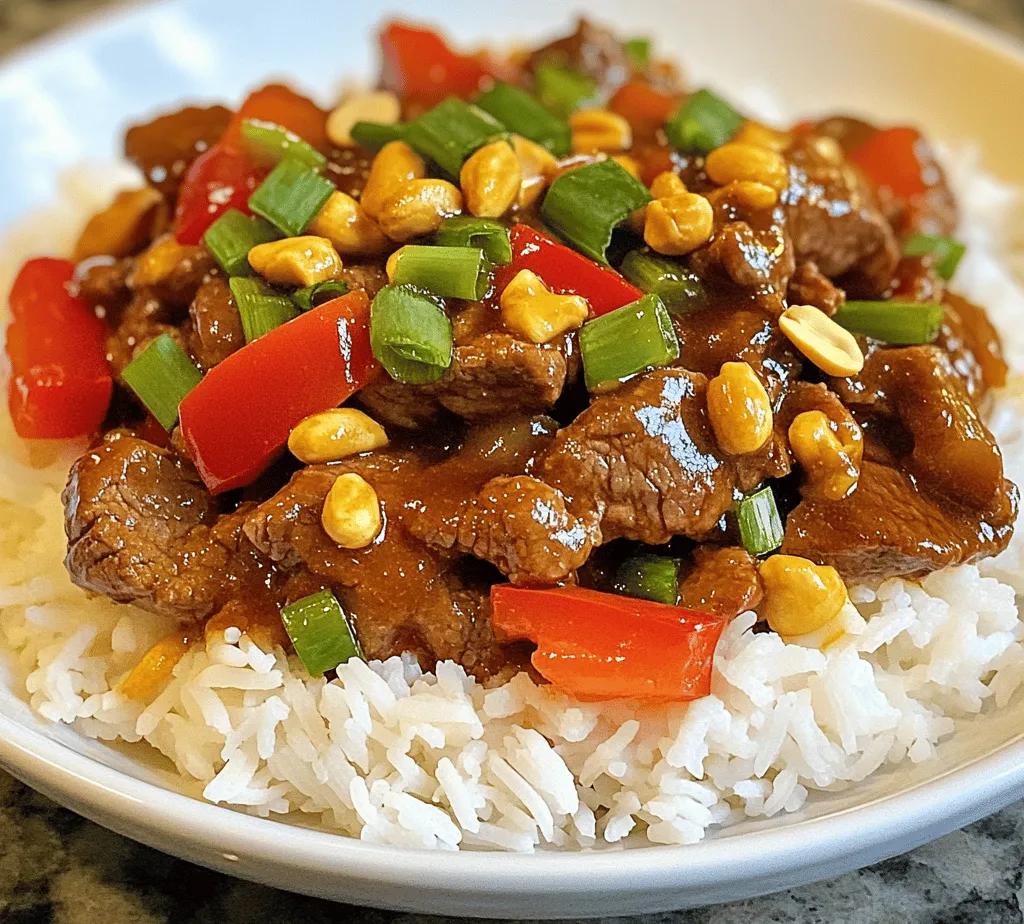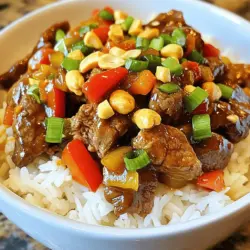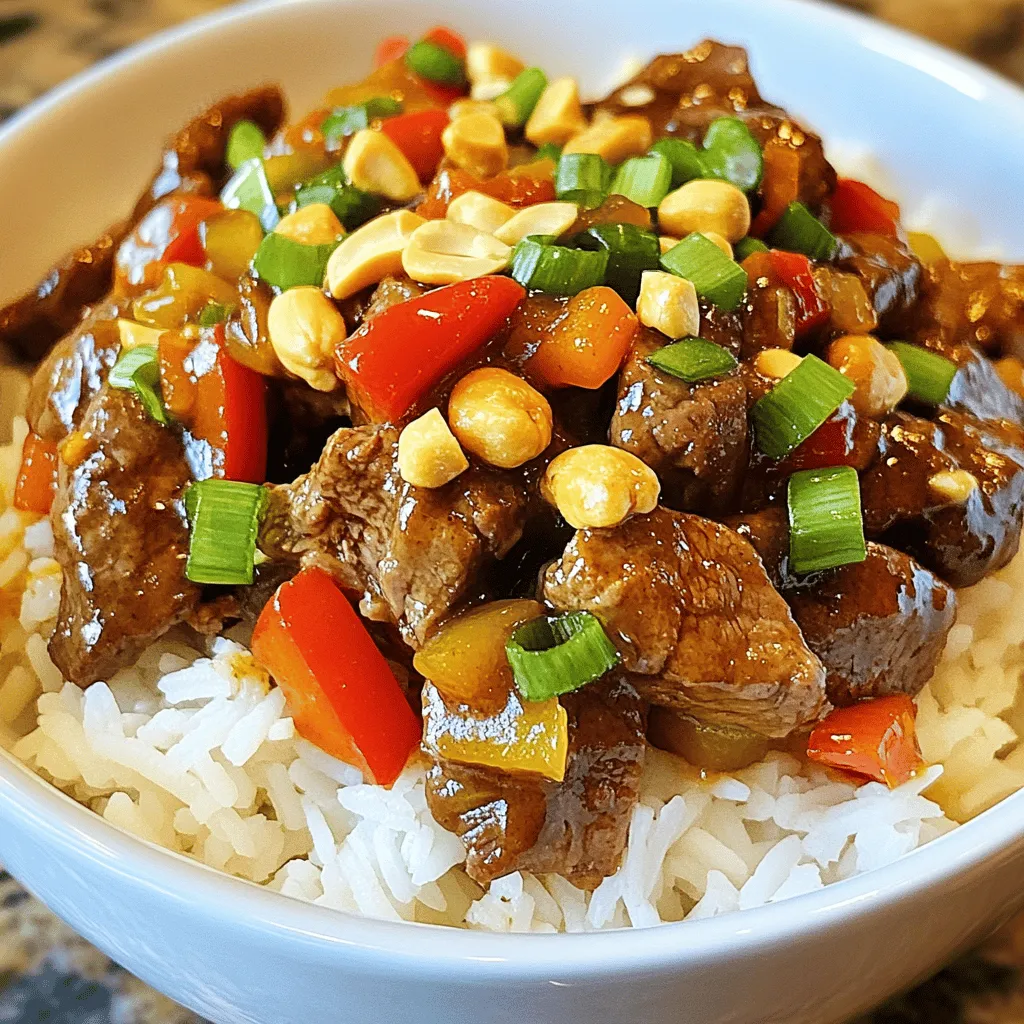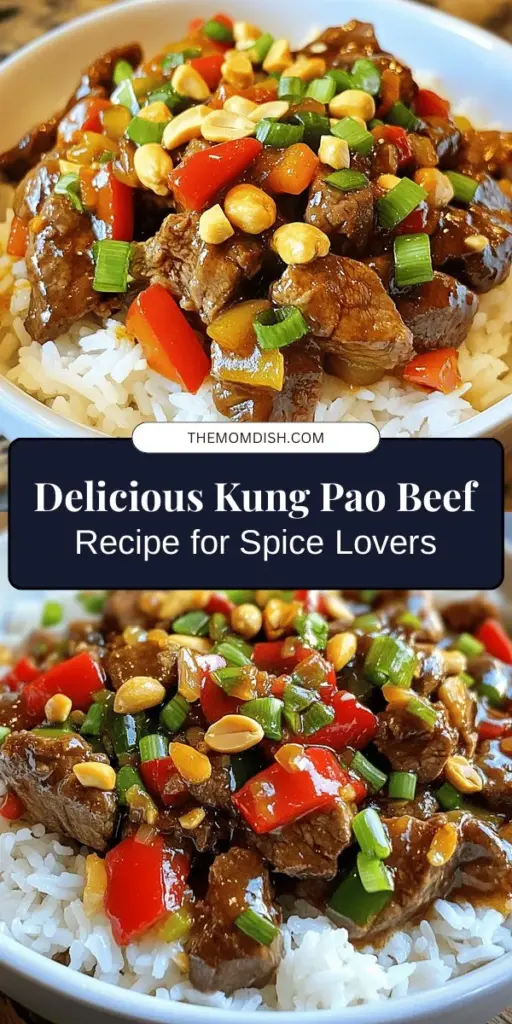Introduction
Kung Pao Beef is a beloved dish that hails from the rich tapestry of Chinese cuisine, offering a perfect fusion of heat, flavor, and texture. Originating from the Sichuan province, this dish is not only famous for its spicy kick but also for its cultural significance and historical roots. Traditionally, Kung Pao was prepared with chicken, but over time, variations like Kung Pao Beef have emerged, delighting spice lovers across the globe.
What sets Kung Pao Beef apart is its unique medley of ingredients that create a harmonious balance of flavors. The tender beef, crisp vegetables, and crunchy peanuts come together to provide a satisfying and unforgettable culinary experience. This dish is more than just a meal; it’s a celebration of bold flavors and vibrant ingredients, making it suitable for any dinner table. Whether you’re hosting a family dinner or looking for a dish to impress guests, Kung Pao Beef is sure to become a favorite.
In this article, we will delve into the essential ingredients that contribute to the dish’s signature taste and provide detailed preparation steps to ensure your Kung Pao Beef turns out perfectly. Get ready to embark on a flavorful journey as we explore this spicy delight!
Understanding the Ingredients
To truly appreciate Kung Pao Beef, it’s essential to understand the key ingredients that come together to create its distinctive flavor profile. Each component plays a vital role in achieving the dish’s unique taste and texture.
Beef Sirloin
The star of Kung Pao Beef is undoubtedly the beef, and sirloin is the preferred cut for this dish. Sirloin is known for its balance of tenderness and flavor, making it ideal for stir-frying. When cooked correctly, it becomes succulent and juicy, enhancing the overall enjoyment of the dish. The marbling of fat within the sirloin adds richness, ensuring that each bite is packed with flavor.
When preparing your Kung Pao Beef, aim for thin slices of sirloin. This not only helps the meat cook quickly but also allows it to absorb the marinade and flavors from the sauce more effectively.
Bell Peppers
Bell peppers are another key ingredient that contributes to the dish’s vibrant appearance and flavor. Typically, a mix of red and green bell peppers is used, providing a colorful contrast that is visually appealing. Beyond aesthetics, bell peppers add a sweet crunch that balances the heat from the spices. Their subtle flavor complements the beef without overpowering it, making them an integral component of the dish.
Peanuts
One of the defining features of Kung Pao Beef is the addition of peanuts. These nuts bring a delightful crunch and richness that enhances the overall texture of the dish. Toasted peanuts also add a nutty flavor that perfectly complements the savory elements of the sauce. Additionally, peanuts are a great source of protein, making this dish even more satisfying.
Aromatic Ingredients
The aromatic ingredients—garlic and ginger—are crucial for building depth in the dish. Garlic adds a pungent aroma and a savory kick, while ginger provides warmth and a hint of spiciness. Both ingredients not only elevate the flavor but also offer numerous health benefits, including anti-inflammatory properties and digestive support. The combination of garlic and ginger creates a fragrant base that enhances the overall taste of Kung Pao Beef.
Dried Red Chilies
To achieve the signature spiciness of Kung Pao Beef, dried red chilies are used. These chilies infuse the dish with heat and a touch of smokiness, making them essential for any spicy food enthusiast. When selecting dried chilies, consider the level of heat you prefer; Sichuan peppercorns can also be added for a distinctive numbing sensation that is characteristic of Sichuan cuisine.
Sauces
The sauce is where the magic happens in Kung Pao Beef, and several key sauces are used to create its complex flavor profile:
– Soy Sauce: A staple in Chinese cooking, soy sauce adds umami and saltiness to the dish. For Kung Pao Beef, a combination of light and dark soy sauce is often used. Light soy sauce contributes saltiness, while dark soy sauce adds depth and color.
– Hoisin Sauce: This sauce is known for its sweet and tangy flavor, which helps balance the heat from the chilies. Hoisin sauce adds a layer of complexity that enhances the overall taste of the dish.
– Rice Vinegar: To achieve a well-rounded flavor, rice vinegar is incorporated into the sauce. Its mild acidity helps cut through the richness of the beef and peanuts, making each bite refreshing.
– Sesame Oil: Finally, a drizzle of sesame oil is used as a finishing touch. This oil adds a rich, nutty flavor that elevates the dish and rounds out the overall taste profile.
Preparation Steps Explained
Now that we understand the importance of each ingredient, it’s time to break down the preparation steps for Kung Pao Beef. These steps are crucial for ensuring that the dish is bursting with flavor and has the perfect texture.
Marination Process
Marinating the beef is a vital step that enhances both flavor and tenderness. The marinade typically consists of soy sauce, a dash of rice vinegar, and cornstarch. Here’s how to do it:
1. Slice the Beef: Begin by slicing the sirloin against the grain into thin strips. This will help ensure that the beef remains tender when cooked.
2. Prepare the Marinade: In a bowl, combine the sliced beef with soy sauce, rice vinegar, and a tablespoon of cornstarch. The cornstarch acts as a tenderizer and helps create a velvety texture once cooked.
3. Let It Marinate: Allow the beef to marinate for at least 30 minutes. This step is crucial as it allows the flavors to penetrate the meat and results in a more flavorful dish.
Preparing the Sauce
Creating the perfect Kung Pao sauce is essential for achieving that signature taste. Here’s a step-by-step guide to preparing the sauce:
1. Combine the Ingredients: In a separate bowl, mix together soy sauce, hoisin sauce, rice vinegar, and a splash of water. Adjust the proportions to suit your taste preferences, ensuring a balance of savory, sweet, and tangy flavors.
2. Add Aromatics: Incorporate minced garlic and ginger into the sauce mixture. These aromatics will infuse the sauce with their robust flavors, enhancing the overall dish.
3. Set Aside: Once combined, set the sauce aside while you prepare the other ingredients. Allowing the sauce to sit for a few minutes will help the flavors meld together.
Cooking Techniques
Stir-frying is the key cooking technique for Kung Pao Beef, and it’s important to use high heat to achieve the desired flavor and texture. Here’s how to do it effectively:
1. Preheat the Pan: Heat a wok or large skillet over high heat until it is very hot. A well-heated pan is essential for proper stir-frying, as it allows the beef to sear quickly and develop a delicious crust.
2. Cook the Beef: Add a small amount of oil to the pan, then quickly add the marinated beef. Stir-fry for just a few minutes until the beef is browned and cooked through. Avoid overcrowding the pan to ensure even cooking.
3. Add Vegetables and Peanuts: Once the beef is cooked, remove it from the pan and set it aside. In the same pan, add bell peppers and peanuts, stir-frying until the vegetables are tender-crisp.
4. Combine Everything: Return the cooked beef to the pan, pour in the prepared sauce, and toss to coat everything evenly. Stir-fry for an additional minute to allow the sauce to heat through and thicken slightly.
By following these detailed steps, you’ll ensure that your Kung Pao Beef is packed with flavor and has the perfect balance of tender meat, crispy vegetables, and a delightful crunch from the peanuts. As you prepare this dish, you’ll find that the combination of high heat and well-balanced ingredients creates a culinary experience that is both satisfying and memorable. With its vibrant flavors and textures, Kung Pao Beef is sure to become a staple in your cooking repertoire.

Tips for Achieving Optimal Sear on Beef
Achieving a perfect sear on the beef is essential for developing rich flavors in your Kung Pao Beef. Here are some tips to ensure your beef is seared to perfection:
1. Choose the Right Cut: Opt for cuts such as flank steak or sirloin, which are tender and flavorful. These cuts also lend themselves well to quick cooking methods.
2. Pat the Beef Dry: Moisture is the enemy of a good sear. Use paper towels to pat the beef dry before seasoning. This will help it caramelize better when it hits the hot pan.
3. Preheat Your Pan: Heat a heavy-bottomed skillet or wok over medium-high heat until it’s very hot. You can test the heat by adding a drop of water; if it sizzles and evaporates quickly, the pan is ready.
4. Use High Smoke Point Oil: Choose oils with high smoke points, such as canola, peanut, or grapeseed oil. These oils withstand higher temperatures without burning and will help achieve a good sear.
5. Don’t Overcrowd the Pan: Work in batches if necessary. Overcrowding the pan can lower the temperature and lead to steaming rather than searing. This prevents that delicious crust from forming.
Sautéing Aromatics
Once your beef is perfectly seared, it’s time to sauté the aromatics, which are key to building the flavor base of your Kung Pao Beef.
1. Timing is Crucial: The order in which you add aromatics is essential. Start by adding minced garlic and ginger to the pan immediately after the beef is cooked. They should only be sautéed for about 30 seconds to a minute until fragrant. This quick cooking time helps to release their essential oils without burning, which can impart a bitter taste.
2. Add the Peppers: Next, add diced bell peppers and scallions. The vibrant colors and fresh flavors from these vegetables enhance the dish and add a slight crunch. Sauté them for an additional 1-2 minutes until they soften slightly but still retain some crispness.
Combining Ingredients
Combining all the elements of your Kung Pao Beef is the final step before serving. Here’s how to effectively toss and coat the ingredients for even flavor distribution:
1. Return the Beef to the Pan: Once the aromatics and vegetables are sautéed, return the seared beef to the pan. Stir to combine all the ingredients evenly.
2. Add the Sauce: Pour your prepared Kung Pao sauce over the beef and vegetables. Make sure the sauce coats everything evenly. Use a spatula to toss the ingredients together gently for about 2-3 minutes, allowing the sauce to thicken slightly and envelop all the flavors.
3. Final Touches: If using roasted peanuts, add them during the last minute of cooking. This ensures they remain crunchy and provide a delightful contrast to the tender beef and vegetables.
Serving Suggestions
Presentation is key when serving Kung Pao Beef, as it enhances the dining experience. Here are some ideas:
1. Plating: Serve the Kung Pao Beef in a shallow bowl or on a large platter. This allows the vibrant colors of the dish to shine through. Consider garnishing with finely sliced scallions or sesame seeds for added texture and visual appeal.
2. Complementary Side Dishes: Pair your Kung Pao Beef with steamed jasmine rice, which balances the spiciness of the dish. Alternatively, try serving it with stir-fried noodles or sautéed seasonal vegetables for a complete meal that offers a variety of flavors and textures.
3. Garnishing Ideas: Fresh herbs like cilantro or additional crushed peanuts sprinkled on top can elevate the dish. A drizzle of sesame oil just before serving can also enhance the flavor profile and add a glossy finish.
Nutritional Information
Understanding the nutritional content of your Kung Pao Beef can help you enjoy it as part of a balanced diet. Here’s a breakdown:
– Calories and Macronutrients: A typical serving of Kung Pao Beef contains approximately 350-400 calories, depending on portion size and specific ingredients used. It generally offers around 25g of protein, 20g of carbohydrates, and 20g of fat, primarily from the peanuts and oil used in cooking.
– Health Benefits: The primary ingredients in Kung Pao Beef provide numerous health benefits. The beef is a great source of protein, which is vital for muscle building and repair. Peanuts add healthy fats and provide a good amount of vitamin E and magnesium. Bell peppers and scallions contribute essential vitamins, including vitamin C and antioxidants, promoting overall health.
– Balancing Spiciness with Nutritious Vegetables: Incorporating a variety of colorful vegetables not only enhances the dish’s flavor but also increases its nutritional value. Consider adding broccoli, snap peas, or zucchini for added fiber and nutrients.
Variations of Kung Pao Beef
One of the great aspects of Kung Pao Beef is its versatility. You can easily adapt this recipe to suit different tastes and dietary preferences:
1. Different Protein Options: If you prefer chicken, tofu, or shrimp, simply substitute the beef with your desired protein. Cook them in the same way, adjusting cooking times as necessary (shrimp cooks faster than beef, for example).
2. Adjusting Spice Levels: If you enjoy milder flavors, reduce the amount of chili paste or omit the dried red chilies. For those who crave extra heat, consider adding fresh sliced chili peppers or a dash of chili oil to amp up the spiciness.
3. Vegetarian or Vegan Adaptations: For a vegetarian or vegan version, swap out the beef for firm tofu or tempeh. Ensure that the soy sauce used is vegan-friendly. You can also add more vegetables to create a heartier dish.
Culinary Tips
To ensure your Kung Pao Beef is a success, keep these culinary tips in mind:
1. Best Practices for Stir-Frying: Stir-frying requires high heat and quick cooking. Always have all your ingredients prepped and ready to go before you start, as stir-frying is a fast-paced cooking method.
2. Selecting Fresh Ingredients: Fresh vegetables and high-quality beef will significantly enhance the flavor of your dish. Look for vibrant colors in your vegetables and choose cuts of beef with good marbling for tenderness.
3. Storage Recommendations: Leftover Kung Pao Beef can be stored in an airtight container in the refrigerator for up to 3 days. To maintain its flavor and texture, reheat gently in a skillet over low heat, adding a splash of water or broth to keep it moist.
Conclusion
Making Kung Pao Beef at home is a delightful culinary adventure that combines bold flavors and satisfying textures. Each step, from searing the beef to tossing the ingredients in a flavorful sauce, contributes to a dish that is not only delicious but also rewarding to prepare.
Exploring your culinary skills by trying out this spicy and savory recipe will surely impress your family and friends. Whether you stick to the traditional recipe or experiment with different proteins and spice levels, Kung Pao Beef is a versatile dish that can be customized to suit any palate. So gather your ingredients, unleash your inner chef, and enjoy the journey of creating this flavorful masterpiece in your own kitchen.



